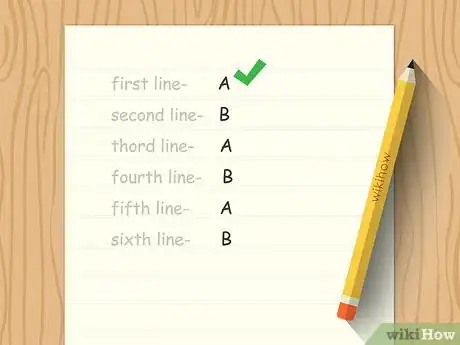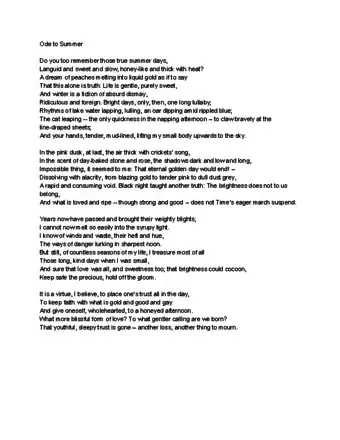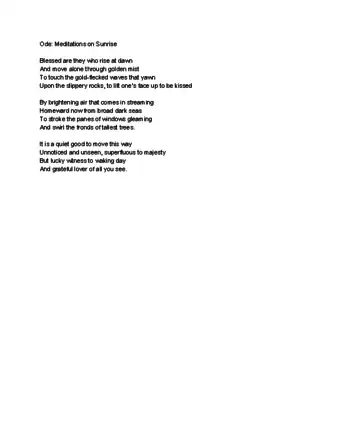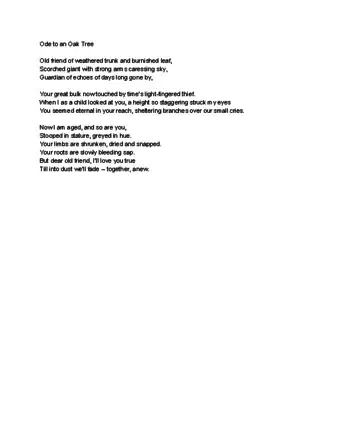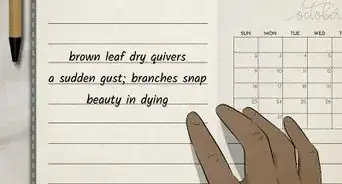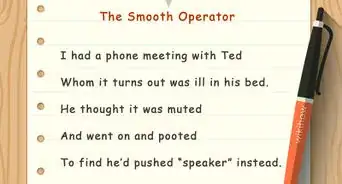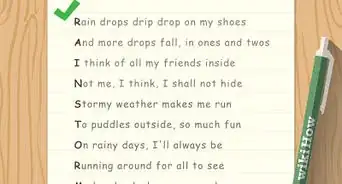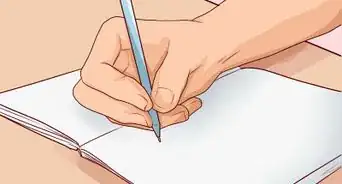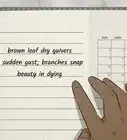X
This article was co-authored by wikiHow staff writer, Jennifer Mueller, JD. Jennifer Mueller is a wikiHow Content Creator. She specializes in reviewing, fact-checking, and evaluating wikiHow's content to ensure thoroughness and accuracy. Jennifer holds a JD from Indiana University Maurer School of Law in 2006.
This article has been viewed 60,289 times.
Learn more...
An ode is a poem written to praise and celebrate a person, an event, a time, or an object. While this poetic form originated in ancient Greece, it survives today as a popular way to convey passion and strong sentiment toward the subject. With its use of description and repetition, an ode is a relatively accessible poetic form that even beginners can write.[1]
Steps
Part 1
Part 1 of 3:
Choosing Your Subject Matter
-
1Think of things you're passionate about. More serious odes are typically written about something (or someone) the poet feels deeply connected to. Since odes are about a single person or thing, they are easier to write if you start with something you have strong feelings about.[2]
- When starting out, brainstorm a list of possible topics. You might include your favorite foods, your favorite holiday, or important people in your life.
- Odes about people tend to be more serious, and more sincere, than odes about other things – but they don't have to be. You could write an ode to your mother, for example, that was still light-hearted and full of loving humor.
-
2Use a common object for humor. Some of the best humorous odes are written about common objects that most people wouldn't think someone would have a deep passion for. Writing about a common object provides the opportunity for humor while also giving your reader a chance to see the object in a new light, and grow a new appreciation for it.[3]
- For example, if you work in an office, you might consider writing an ode to the copier. In most offices, this is not a machine anyone would think to thank or sing praises to. On the contrary, it is the source of much office frustration.
- An ode to a common object you genuinely appreciate can also draw attention to that object and help others who read your poem see that they may have taken that object for granted. For example, you might write an ode to your coffee maker, or an ode to your headphones.
Advertisement -
3Read odes written by established poets. Reading the work of others can inspire you as well as give you ideas for how to approach your subject matter. Published classic odes can also give you greater understanding and familiarity of the poem's structure.[4]
- The Academy of American Poets has more than 8,000 poems, including odes, that you can read online for free. Go to https://www.poets.org/poetsorg/poems?field_form_tid=417 to read some famous odes of all types.
- For a fun ode about an everyday drink, try "Ode to Kool-Aid" by Marcus Jackson. "Ode to My Socks," by Pablo Neruda, is an ode about a common object by a famous poet.
- William Wordsworth's "Ode on Intimations of Immortality from Recollections of Early Childhood" is a good example of a Pindaric ode. If you're looking for a Horatian ode, try "Ode to the Confederate Dead," by Allen Tate.
-
4Talk to friends to brainstorm topics. If you're still stuck, meet up with a friend or two and have a conversation. You will probably gravitate towards talking about things you have in common that you love. Any of those things could be the subject of an ode.[5]
- For example, if you get together with a group of friends and the conversation instantly turns to the latest Star Wars movie, you might consider writing an ode to your favorite character from the films.
Advertisement
Part 2
Part 2 of 3:
Setting Your Structure
-
1Use a classical structure if you want more formality. There are two main types of classical odes: the Pindaric and the Horatian odes. These types use very formulaic structures with complex meter and specific rhyme schemes.[6]
- The Pindaric ode starts with a formal opening called a strophe, followed by an antistrophe that mirrors the structure of the opening. It closes with an epode, a longer stanza with an entirely different metrical structure than the strophe and antistrophe.
- The Horatian ode is less formal than the Pindaric ode, and uses a recurring stanza pattern. The Horatian structure may be used to particularly good effect if you're writing a more humorous ode, since the formality of the structure would contrast with the substance of your poem.
-
2Try the irregular form if you want more freedom. If you feel constrained using a classical structure, the irregular form may be better for you. This form gives you more freedom to experiment with rhyme and meter, while still maintaining the tone and theme of a classical ode.[7]
- Even when using the irregular form, consistency is the hallmark of an ode. While you're free to choose your own meter and rhyme scheme with the irregular form, whatever scheme you choose should be employed consistently throughout your poem.
-
3Determine how long you want your ode to be. Odes are typically longer poems. If you're writing about something for which you have a lot of strong feelings, it shouldn't be difficult to come up with a lot of things you want to say.[8]
- A classic ode is at least 4 stanzas, but you can make yours as long (or as short) as you want.[9]
-
4Write out your rhyme scheme. Odes don't necessarily have to rhyme, but most of them have some kind of rhyme scheme. While you can choose whatever rhyme scheme you want (if you're writing in the irregular form), keep it consistent throughout your poem.[10]
- It can help to note the rhymes on the margins of the paper where you write your ode. For example, if you've decided you're going to rhyme every other line of a six-line stanza, you might write "ABABAB" to indicate that the first line will rhyme with the third and fifth, while the second line will rhyme with fourth and sixth.
Advertisement
Part 3
Part 3 of 3:
Crafting Your Poem
-
1Tap into your emotion. When you sit down to start writing your ode, fully immerse yourself in your subject. You may want to briefly meditate on your subject, or listen to music that reminds you of your subject to put you in the right frame of mind.[11]
- It can help to find a quiet place to write where you can be alone with minimal distractions. That will give you the freedom to dive into your subject.
- Depending on the subject of your ode, you may find strong emotional responses rising to the surface. For example, you might find that you start to cry. Don't be afraid to use that emotional response in your poem. Deep passion can evoke some of the best imagery.
-
2Brainstorm descriptions and associations. Odes are frequently heavy on similes, metaphors, and imagery. To get started with your poem, write down words and images that come to mind when you think of your subject.[12]
- For example, if you're writing an ode to your coffee maker, you might include words such as dark, aroma, rich, bold, hot, and steamy. You could compare the coffee grounds to the earth or the soil.
-
3Make a list of verbs. Verbs will help you bring the subject of your ode to life. If you're writing about a person or living creature, this list will be fairly direct. If you're writing about an inanimate object, use this list to personify the object.[13]
- To continue with the coffee maker example, you might list verbs such as bubble (up), brew, drip, pour, and steam. You could also include words such as rising or percolating.
-
4Identify your subject throughout your poem. A traditional ode begins by naming the subject of the poem, typically preceded by the word "oh." This line may be repeated at the beginning of each stanza, or sporadically throughout the poem.[14]
- You can be as specific or general as you want. If you're writing an ode to your coffee maker, you could use the brand name of the coffee maker, or you could simply start your poem "Oh, coffee maker" or "Oh, coffee pot." Depending on your rhyme scheme, you may want to choose a name that is easier to rhyme with other words.
-
5Address your poem directly to your subject. An ode is written, essentially, to an audience of one – the subject that you are praising, thanking, or honoring. Although others may be reading your ode, when you use the second-person pronoun you in an ode, you're referring to the subject of the ode.[15]
- This can be difficult if you're writing an ode to an inanimate object, since you may not be in the habit of speaking directly to inanimate objects. Repeating your first line can help you stay focused on the perspective. For example, you might start every stanza "Oh, coffee pot." If this starts to feel too monotonous, you can always take some of them out when you edit.
-
6Weave your ideas together into your poem. Armed with your lists of adjectives, images, and verbs, start organizing them into a cohesive story. You may find it easier to work on pieces of your poem and fit them together, rather than starting with the first line and writing straight through to the last.
- As you read through your lists, you'll likely find that some images or thoughts naturally lead into each other.
- For example, if you're writing an ode to your coffee maker, you might note that the idea that the steam rises from the freshly-brewed coffee flows perfectly into how drinking the coffee helps you to wake up in the morning. You could write "Oh coffee maker, as brewing your steam rises and wafts through the air, so I rise from fitful slumber."
-
7Edit your work. After you've written a draft of your ode, set it aside for at least a few hours, if not a whole day. Then return to it and read it aloud. Look for areas that need smoothing or clarification. Reading your ode aloud also helps you establish the rhythm of the poem.
- A line or section that causes you to stumble as you read aloud presents an opportunity to improve the writing so that it flows more smoothly.
- Check your grammar and spelling, and make sure the rhyme and rhythm you established is consistent throughout your poem.
-
8Share your ode with others. Once you have what you feel is the final version of your ode, let others read it and provide their thoughts. Use feedback from readers to improve your ode further, making note of lines that seemed to resonate strongly.[16]
- Sharing your work with others may open you up to negative feedback and criticism. If it's constructive, use it to improve your work and become a stronger poet. If it's not constructive, just ignore it. Try not to take criticism personally.
Advertisement
Ode Examples
Community Q&A
-
QuestionHow do I write an ode to joy?
 Tom De BackerTop AnswererThe fact that it's already been done creates an extra standard which your efforts will have to meet. It will not only be weighed for its own merits, but will be compared to Schiller's and Beethoven's works as well, which are pretty large shoes to fill. But if you feel you have something to write, write. You've already found a topic, now find a kernel, and idea, and expand from there.
Tom De BackerTop AnswererThe fact that it's already been done creates an extra standard which your efforts will have to meet. It will not only be weighed for its own merits, but will be compared to Schiller's and Beethoven's works as well, which are pretty large shoes to fill. But if you feel you have something to write, write. You've already found a topic, now find a kernel, and idea, and expand from there. -
QuestionHow many lines should each stanza include in an ode?
 Tom De BackerTop AnswererThere doesn't seem to be a fixed length defined for odes. Usually there's three parts: the strophe, anthistrophe and epode, each consisting of at least one stanza, where a stanza is a complete unit in itself. So if you have three lines in each stanza, the only available rhyming scheme would be AAA, because if you do for example ABA, you haven't tied up the B rhyme yet, and the stanza won't be considered closed until you do. You could have four lines in each stanza, opening up more options: ABAB, AABB, ABBA. So the shortest ode would be AAA-BBB-CCC. There are no obvious rules for meter, either.
Tom De BackerTop AnswererThere doesn't seem to be a fixed length defined for odes. Usually there's three parts: the strophe, anthistrophe and epode, each consisting of at least one stanza, where a stanza is a complete unit in itself. So if you have three lines in each stanza, the only available rhyming scheme would be AAA, because if you do for example ABA, you haven't tied up the B rhyme yet, and the stanza won't be considered closed until you do. You could have four lines in each stanza, opening up more options: ABAB, AABB, ABBA. So the shortest ode would be AAA-BBB-CCC. There are no obvious rules for meter, either.
Advertisement
References
- ↑ https://www.poets.org/poetsorg/text/ode-poetic-form
- ↑ https://www.powerpoetry.org/resources/writing-ode-poem
- ↑ http://www.webexhibits.org/poetry/explore_classic_ode_make.html
- ↑ http://www.webexhibits.org/poetry/explore_classic_ode_make.html
- ↑ https://www.scholastic.com/teachers/blog-posts/danielle-mahoney/explore-poetry-that-turns-the-ordinary-into-extraordinary-write-an-ode/
- ↑ https://www.poets.org/poetsorg/text/ode-poetic-form
- ↑ https://www.poets.org/poetsorg/text/ode-poetic-form
- ↑ https://www.powerpoetry.org/resources/writing-ode-poem
- ↑ http://www.webexhibits.org/poetry/explore_classic_ode_make.html
- ↑ https://www.powerpoetry.org/resources/writing-ode-poem
- ↑ https://www.powerpoetry.org/resources/writing-ode-poem
- ↑ https://www.youngwriters.co.uk/types-ode
- ↑ https://www.scholastic.com/teachers/blog-posts/danielle-mahoney/explore-poetry-that-turns-the-ordinary-into-extraordinary-write-an-ode/
- ↑ https://www.scholastic.com/teachers/blog-posts/danielle-mahoney/explore-poetry-that-turns-the-ordinary-into-extraordinary-write-an-ode/
- ↑ https://www.scholastic.com/teachers/blog-posts/danielle-mahoney/explore-poetry-that-turns-the-ordinary-into-extraordinary-write-an-ode/
- ↑ https://www.scholastic.com/teachers/blog-posts/danielle-mahoney/explore-poetry-that-turns-the-ordinary-into-extraordinary-write-an-ode/
About This Article
Advertisement







